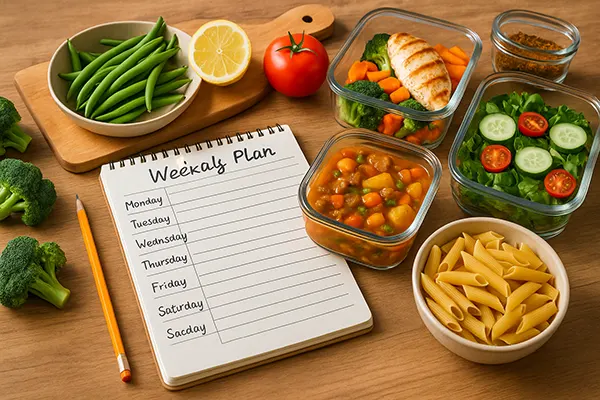
Family Weekly Meal Plan: How to Save Time, Money and Reduce Waste
Organising a weekly meal plan for the whole family is one of the most effective ways to manage your household budget, ensure balanced nutrition, and minimise food waste. In 2025, with rising food prices and busy schedules, having a clear structure for meals not only helps you save money but also reduces daily stress over what to cook. A well-thought-out plan allows you to buy only what you need, make the most of seasonal produce, and prepare meals in advance.
Benefits of a Structured Meal Plan
A family meal plan saves time by reducing the need for daily decisions about what to eat. Instead of making last-minute trips to the supermarket, you can do one or two well-organised shopping sessions per week. This prevents impulse purchases and ensures you always have the right ingredients at hand. Planning also helps balance your diet, making it easier to include the recommended portions of vegetables, fruits, proteins, and whole grains.
From a financial perspective, meal planning is a key tool for cutting costs. By knowing exactly what you need, you can buy in bulk for non-perishable items and take advantage of discounts without overbuying fresh foods that might spoil. According to recent UK consumer studies in 2025, households that follow a strict weekly meal plan save an average of 20% on their grocery bills.
Additionally, a structured plan significantly reduces food waste. By using leftovers creatively and ensuring perishable items are incorporated into meals before they expire, families contribute to environmental sustainability while saving money.
Practical Examples from Real Families
One example comes from a London-based family of four who prepare a weekly plan every Sunday. They cook large batches of certain dishes, such as soups or stews, and freeze portions for busier days. They also rotate meals, ensuring variety without spending excessive time on cooking. This approach has cut their food expenses by nearly a quarter over the past year.
Another case is a couple from Manchester who use a shared digital calendar to organise their meals. They plan dinners around their work schedules and children’s activities, preparing quicker recipes on busier evenings and more elaborate dishes at weekends. By doing so, they avoid takeaway orders, which has improved both their health and finances.
Families in rural areas often incorporate home-grown produce into their plans, further reducing costs. This includes preserving seasonal fruits and vegetables through freezing or canning, allowing them to enjoy home-grown food year-round.
How to Create an Effective Meal Plan
Start by assessing your family’s schedule for the week. Identify busy days when cooking time will be limited, and plan simpler meals for those days. Reserve more time-consuming recipes for weekends or days off. Make sure to consider everyone’s dietary needs and preferences to ensure meals are both nutritious and appealing.
Next, create a shopping list based on your chosen recipes. Organise the list by supermarket sections to make shopping more efficient. Include staples such as rice, pasta, and tinned goods, and plan to buy fresh produce that will be used within a few days to maintain quality. Seasonal produce is often cheaper and fresher, so adapt your recipes accordingly.
Finally, dedicate time to meal prep. This could involve chopping vegetables, marinating meat, or pre-cooking grains. By doing some preparation in advance, you can cut cooking time in half during the week, making it easier to stick to your plan.
Tools and Resources to Help You
In 2025, there are numerous apps and online tools that make meal planning easier. Many of them allow you to store recipes, generate shopping lists, and even track expiry dates of your ingredients. Some supermarkets also offer integration with meal planning apps, allowing you to order groceries directly based on your plan.
Printable meal planners remain popular for families who prefer a physical reminder on the fridge. These can be colour-coded to indicate different meal types or family members’ responsibilities in preparation and cooking. Such visual aids help everyone stay on track and reduce the likelihood of missed meals or forgotten ingredients.
Recipe subscription services can also be an option, providing pre-measured ingredients and step-by-step instructions. While slightly more expensive than traditional shopping, they can be cost-effective for households looking to avoid waste and save time on planning.

Maximising Savings and Reducing Waste
One effective strategy is to plan meals that use similar ingredients in different ways. For example, roast chicken can be served fresh one day, turned into a salad the next, and used for a soup later in the week. This approach ensures no food goes unused while keeping meals varied.
Buying in bulk for items with a long shelf life can significantly cut costs. Staples like grains, pulses, and cooking oils can be stored for months without losing quality. For fresh items, consider freezing portions or choosing vegetables with a longer storage life, such as carrots or cabbage.
Keeping track of what you already have at home is essential. A quick pantry check before shopping prevents buying duplicates and helps you build meals around existing supplies. This simple habit can lead to noticeable savings over time.
Realistic Long-Term Planning
Meal planning should be flexible to adapt to unexpected changes, such as an unplanned social event or a sale on certain ingredients. Always have a few quick and versatile recipes on hand that can be prepared with pantry staples.
Over time, your family will develop a list of favourite recipes that can be rotated every few weeks. This reduces the effort of planning while keeping meals interesting. Involving children in planning and preparation can also make them more open to trying new foods.
Lastly, review your plan regularly to identify areas for improvement. Tracking expenses and waste levels will help you refine your approach and maximise the benefits of your family meal plan.
